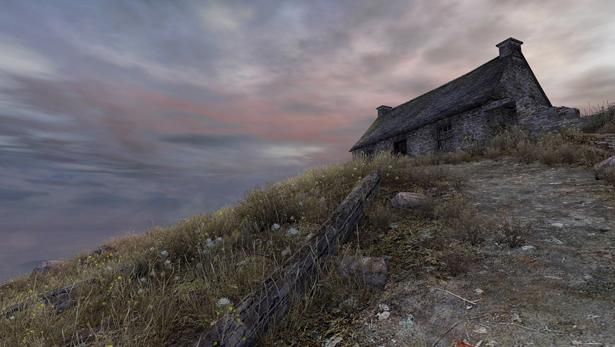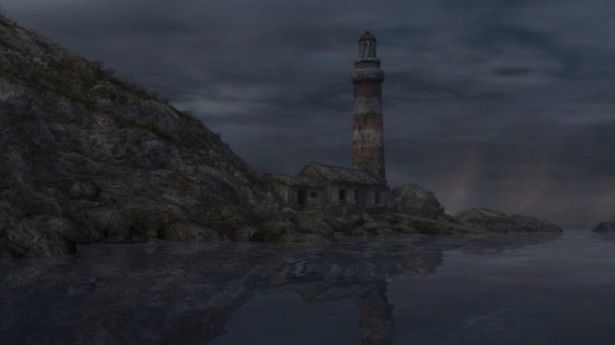Dear Esther is an interesting piece of software. Some people have argued that it isn't even a game. I can see where they come from with that, as it does bear more resemblance to an interactive book than with a traditional game. Developed by thechineseroom, Dear Esther is an indie art game. You might know the type. The kind that some people rave and say are destroying games, the kind that some people call pretentious or arsy or bullshit. Other people go wild over them, studying them like classic literature. I'm sure you know the type, and Dear Esther easily fits that definition perfectly.
First, let me explain to you exactly what you get. Dear Esther is a first person game that has you exploring an island while rustic narrator with an English accent tell syou stories. That's about it. All you do is walk around and look at stuff. There are no items to collect, nor enemies to fight. You can't run, there is no jump button, nothing to climb. It's just WASD to walk, mouse to look around. Using this set up, you explore an island on a semi-linear path while the narrator reads to you.
If you've ever played The Path or anything by Tale of Tales, you know the type of thing you're getting. If this set-up sounds dull, I could understand why you would think so. The appeal lies in the presentation, and especially, the narrative. What the game is built on is its story and world it takes place in. With that in mind, if you want any hope of enjoying Dear Esther, it is best to approach as you would poetry or classic literature.

As you walk around the island, every few minutes, a narrator with a calm, soothing voice and an English accent reads snippets of letters that he wrote to a woman named Esther. In the beginning, it seems as though these are letters by a sailor describing his life, as he makes references to both the woman and people he has known, as well as the features and history of the island. You are never told who you are controlling, be it the narrator, the woman, somebody unrelated, or just a disembodied camera.
The early appeal is the lore of the island, the man's backstory, and his poetic mannerisms in describing it all. It seems like its meant to be taken literally at first. However, as the game goes on, it becomes obvious that there is more to it than that. More and more as you explore the island, the things you see and hear become more cryptic, and more obviously symbolic. The events and identies of the characters are skewed and start to run together. People described as living on the island may possibly be alter egos to people the narrator knew in life, or the other way around. By the end of the game, all except the most obvious fact (there was definitely some kind of car accident at some point) are open to interpretation.
The other half of the game, of course, is the exploration. You walk around a desolate island with only sparse, decaying structures and an occasional bird as your only friends. The point, beyond potential metaphors, I guess, is to explore teh area that the narrator is talking about. I didn't mind this at all, since the scenery in Dear Esther is gorgeous.
And I do mean gorgeous. I'm no graphics whore, but at points, the visuals are almost photorealistic. They are beautifully designed, as well. You are explorign a mountains island with caves and grottos, after all. Although it was supposed to be lonely, walking along the beach in the early sections of the game brought me back to trips my family used to go on to Cape Vincent, on the edge of Lake Ontario. It was almost a bit of mood whiplash, since the design was so pretty that it actually made me nostalgic.
The caves you explore later in the game are just as pretty, with pristine pools of water and dynamic, realistic lighting that glistens off wet rocks. It's gorgeous and a thrill to look at. When you fianlly ascend from the caves into a moonlight lagoon, the first sight is so breathtaking that I couldn't help but take a screenshot:
Of course, the visuals go hand-in-hand with the metphorical nature of the story. In addition to the scenery porn, there are also subtle things to find throughout. Symbols painted on the walls in houses, or example, or photographs left on a table, Bible verses scrawled on rocks, and eventually medical objects and car parts from the narrator's stories. At the very end of the game, as the plot is becoming the most visceral, some of the things you find are so grisly and jarring that it brings to mind Silent Hill.
There are a few issues with the game need to be noted. Not in terms of the gameplay, but minor things that most people would consider bad regardless of their opinions on art games. For starters, the save feature is weird. The game doesn't auto save, at all, not even at the start of chapters. You also can't choose specific chapters until after you complete the entire thing, so if you want to quit (or the game glitches out---see below) then you could lose your progress. You have to quick save and quick load using the F6 and F7 buttons, and you wouldn't know this unless you happen to stumble upon it in the options menu. You can't even load from the title screen. If you come back into the game after a break, you need to start a new game and then quick load.
While there is no real way to die in this game, there is at least one bottomless pit you can fall into. Also, since you are surrounded on all sides by water, its completely possible to just swim off (maybe trying to reach distant scenery which isn't actually part of the game, as I did a couple times.) In both cases, the game rectifies the situation by making the camera fight you, then flickering some images, hearing the narrator whisper, and respawning you back on safe ground.
Personally, I thought that was a terrible idea.In a game like this, if I am not supposed to go somewhere, why let me do it? I never thought I would ask for an invisible wall, but I would have much preferred that to wasting my time trying to swim to something that is unattainable. On top of this, the game actually glitched out three times upon respawning me. The first time, my keyboard controls were disabled. All I could do was look around and exit, the walk buttons wouldn't work. The second time, I was respawned to a black screen that never went anywhere. The third time, I was respawned to some random point I had never seen before. I had no idea where I was and had to re-load a save.
The game is also fairly linear. It does a good job of making the island feel more open than it usually is. This is fine, except for occasionally you won't know where to go next and end up wandering around the same area. There are also some landmarks and objects of interest in the distance that look like they are meant to be reached and/or explored, but aren't, and trying to do so just leads the problem I mentioned above.
Finally, at the very end of the game, nothing happens. I don't mean that philosophically or anything. I mean, you get to the end, watch a brief cutscene, the screen fades to black, then nothing. No game over, no credits, you don't even return to the main menu. I believe the developer said something about this in an interview, about how it was done intentionally and meant to give the audience time to ponder, but I found it annoying. I stared at a black screen for several minutes expecting something to happen, including thinking the game might have frozen, before I finally realized I was supposed to manually quit.
That's a lot of complaining. I don't mean to keep going on and on. They are just minor issues. If the premise hasn't turned you off yet, then these little complaints probably won't ruin the game for you. If you every play the game, though, just keep them in mind and adapt accordingly, as it will help to avoid some potential inconveniences.

As for how I can recommend the game, well, that's one of the hardest parts. Unfortunately, at its regular price of $9.99 on Steam, I just can't recommend it. No matter how you might feel about artsy indie games, the game is too short and it doesn't have enough in it to justify spending that much. Steam summer sales are over, which means it will probably be a while before it drops to five bucks again. At the peak of the summer Steam sales, Dear Esther was on sale for $2.49, which I bought it at. If you think of it as admission price to a show, then two and a half bucks is about perfect. If you want it.
Personally, I enjoyed the game. I like the visuals and the story intrigued me (the narrator's voice didn't hurt either. You could listen to that guy read the phone book and it would be interesting.) Plus, as a book lover, I'm into that kind of stuff anyway. Dear Esther isn't for everyone, though. Whether you like it is more about you and your tastes than the game itself. If what I've written hasn't turned you off yet, then picture yourself in this scenario:
You are in a small, hole-in-the-wall used book store off the main drive. You find a beat-up old book of poetry by a bunch of no-names. You pay a couple bucks for it, sit down in a chair in the back corner and bury your nose in it for about an hour. It's a tad loquacious, but you have no qualms. Could you realistically picture yourself in this situation? Would it be of your own volition, and would you enjoy it? Yes, no, maybe? Think carefully, because your answer to thisquestion and your answer to whether you'll enjoy Dear Esther are likely to be one in the same.
No comments:
Post a Comment